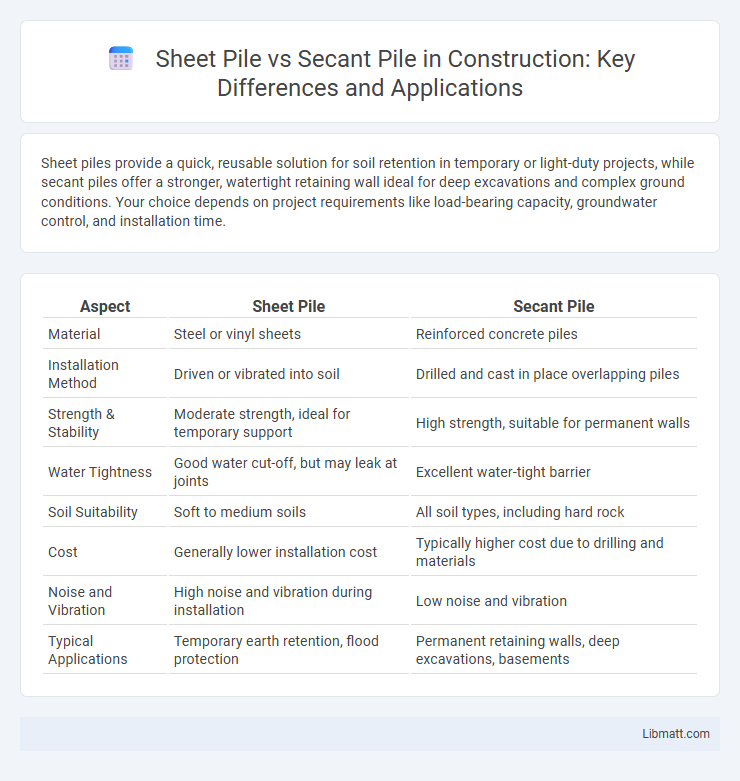Sheet piles provide a quick, reusable solution for soil retention in temporary or light-duty projects, while secant piles offer a stronger, watertight retaining wall ideal for deep excavations and complex ground conditions. Your choice depends on project requirements like load-bearing capacity, groundwater control, and installation time.
Table of Comparison
| Aspect | Sheet Pile | Secant Pile |
|---|---|---|
| Material | Steel or vinyl sheets | Reinforced concrete piles |
| Installation Method | Driven or vibrated into soil | Drilled and cast in place overlapping piles |
| Strength & Stability | Moderate strength, ideal for temporary support | High strength, suitable for permanent walls |
| Water Tightness | Good water cut-off, but may leak at joints | Excellent water-tight barrier |
| Soil Suitability | Soft to medium soils | All soil types, including hard rock |
| Cost | Generally lower installation cost | Typically higher cost due to drilling and materials |
| Noise and Vibration | High noise and vibration during installation | Low noise and vibration |
| Typical Applications | Temporary earth retention, flood protection | Permanent retaining walls, deep excavations, basements |
Introduction to Sheet Pile and Secant Pile
Sheet piles are steel sections driven into the ground to create temporary or permanent retaining walls for excavation support and earth retention, known for quick installation and cost-effectiveness. Secant piles involve constructing overlapping concrete piles reinforced with steel bars, providing superior strength and watertight barriers ideal for complex geotechnical conditions. Your choice between sheet pile and secant pile systems depends on soil conditions, project duration, and structural demands.
Overview of Retaining Wall Technologies
Sheet pile retaining walls are constructed using interlocking steel sheets driven into the ground, providing rapid installation and excellent resistance to lateral earth pressures in soft soil conditions. Secant pile walls involve drilling overlapping reinforced concrete piles, creating a continuous, water-tight barrier ideal for deep excavations and complex geotechnical environments. Both technologies offer distinct advantages depending on site constraints, load requirements, and groundwater control needs.
What Are Sheet Piles?
Sheet piles are interlocking steel sections driven vertically into the ground to form a continuous barrier for earth retention and water cutoff in construction projects. They are commonly used for temporary or permanent retaining walls, cofferdams, and excavation support, offering quick installation and cost-effective solutions. Your choice of sheet piles can significantly impact project stability and groundwater control in challenging soil conditions.
What Are Secant Piles?
Secant piles are overlapping concrete or reinforced concrete piles constructed by drilling and casting a primary pile followed by a secondary pile that cuts into the primary to form a continuous, impermeable wall. These piles provide superior structural support and groundwater cutoff for deep excavation projects, particularly in soft or loose soil conditions. Unlike sheet piles, secant piles offer enhanced load-bearing capacity and are well-suited for complex geotechnical challenges requiring reinforced retaining structures.
Key Differences Between Sheet Pile and Secant Pile
Sheet piles are prefabricated steel sections driven vertically into the ground to provide earth retention and excavation support, offering rapid installation and reusability. Secant piles consist of reinforced concrete columns constructed by overlapping primary and secondary drilled piles, delivering superior watertightness and load-bearing capacity for deep excavation projects. The main differences lie in construction method, structural strength, and suitability for varying soil and hydrogeological conditions.
Installation Methods: Sheet Pile vs Secant Pile
Sheet pile installation primarily involves driving prefabricated steel sections into the ground using vibratory hammers or impact hammers, ensuring rapid and efficient soil retention for temporary or permanent structures. Secant pile installation requires drilling overlapping concrete piles, often reinforced with steel, through wet or dry drilling methods to create a continuous structural wall ideal for water-tight and permanent retaining solutions. The choice of installation method impacts project duration, noise levels, soil displacement, and environmental suitability, making sheet piles favorable for quick deployment and secant piles suited for complex geotechnical conditions.
Advantages of Sheet Pile Walls
Sheet pile walls offer rapid installation and cost-effective solutions for temporary and permanent earth retention in waterfront and urban construction projects. Their interlocking steel sections create a continuous barrier that provides excellent resistance to soil and water pressure while allowing easy removal or reuse. Sheet piles are highly adaptable to varying soil conditions and offer efficient space utilization in confined project sites.
Advantages of Secant Pile Walls
Secant pile walls offer superior structural integrity and water-tightness compared to sheet pile walls, making them ideal for deep excavations in densely populated urban areas. They provide excellent load-bearing capacity and can be designed to handle complex soil conditions and high groundwater pressures. The interlocking nature of secant piles ensures minimal soil movement and enhanced stability, reducing the risk of settlement and damage to adjacent structures.
Common Applications of Each Solution
Sheet piles are extensively used for temporary and permanent earth retention in waterfront structures, excavation support, and flood protection due to their ease of installation and cost-effectiveness. Secant piles are preferred for deep excavation in urban environments, underpinning foundations, and constructing retaining walls where high load-bearing capacity and minimal soil movement are critical. Both solutions serve distinct roles in geotechnical engineering based on project requirements such as soil conditions, structural loads, and environmental constraints.
Choosing the Best Piling System for Your Project
Selecting between sheet pile and secant pile systems depends on project-specific factors such as soil conditions, load requirements, and environmental constraints. Sheet piles offer quick installation and effective water cutoff for temporary or shallow excavations, while secant piles provide superior structural support and groundwater control for deep excavations with complex soil strata. Evaluating parameters like load capacity, project duration, and site accessibility ensures the optimal piling solution for safety and cost-efficiency.
Sheet pile vs secant pile Infographic

 libmatt.com
libmatt.com